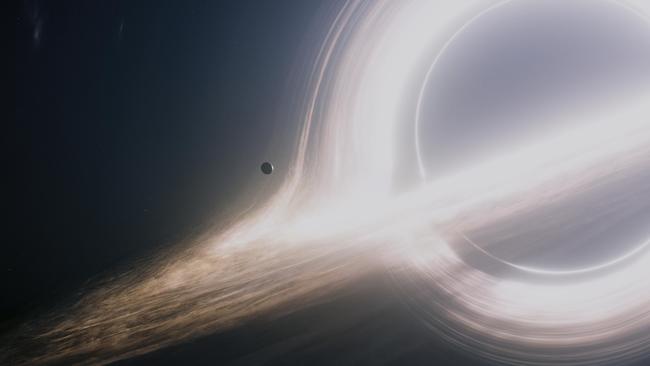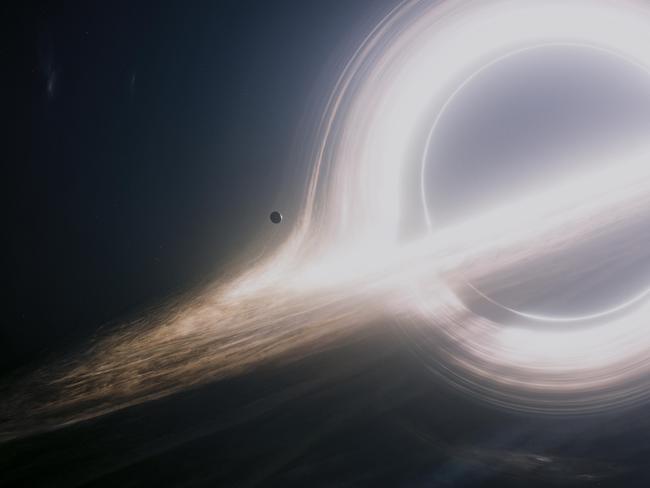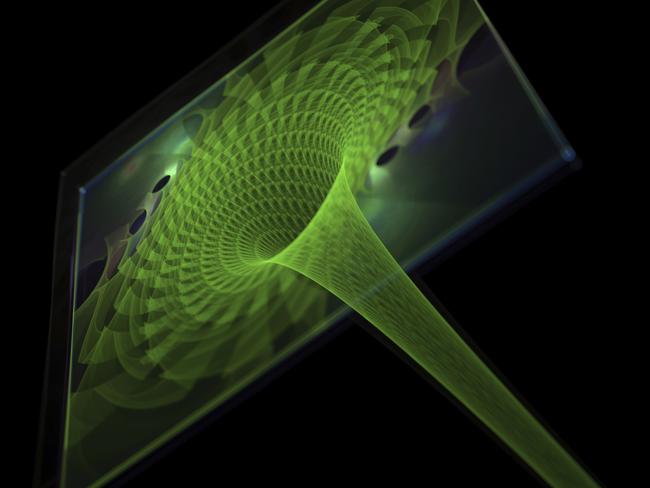Does string theory take the hole out of black holes?
THEY may be black. But are they holes? It seems we may have got the universe’s most awesome phenomenon wrong: Are they instead giant fuzzy photocopiers?

THEY may be black. But are they holes? It seems we may have got the universe’s most awesome phenomenon wrong: Are they really giant fuzzball photocopiers?
When we think ‘black hole’ we get a fairly clear impression in our head: A hole torn in space and time by immense gravity. It’s the idea that they may be some kind of immense ‘trash compactor’, sucking things down to total destruction — or out a ‘back door’ to an unknown destination.
What happens once something crosses a black hole’s ‘event horizon’, the point where even light can no longer resist the pull of gravity, has long been the subject of study and speculation.
A new paper argues we need to turn our old notions on their head.
Professor of physics at Ohio State University Samir Mathur argues that we could be captured by a black hole — and never even notice.
RELATED: Are we living on the edge of a 4D black hole?
He says black holes have no interior. That event-horizon cannot be breached.
Nevertheless, Professor of physics at Ohio State University Samir Mathur argues that anything that reaches the event horizon falls on to it. Not into it.
The original is destroyed. But it is not eliminated.
Instead, it leaves behind an eternal imprint — a hologram embedded in the black hole’s ‘fuzzball’ surface.

It’s about pulling strings
At the core of Professor Mathur’s argument is that the event horizon isn’t a cleanly defined curve. Instead, there is a fuzzy blanket of the fundamental building blocks of the universe coating the boundary.
It’s an idea he came up with based on the controversial string theory of theoretical physics in 2003. He’s spent the past 12 years refining the details.
DARK MATTER: Is this behind Earth’s mass extinctions?
String theory is the notion that the basic substance of the universe is a one dimensional strand, or string, of energy. The manner in which each string ‘vibrates’ determines the physical properties of our three-dimensional existence.
Professor Mathur’s idea is that black holes are where the universe reverts to this ultra-basic state: Everything has been stripped back into a giant bundle of primordial strings.
String theory also produces the notion that three dimensional universe is actually a hologram projected from a universe of many more dimensions.
Everything is forever
It’s an idea that offers an alternative to famous physicist Steven Hawking’s groundbreaking ideas about the nature of black holes.
Hawking argues black holes are drain-like gravitational vortices which pull material through the event horizon. He is famous for his theoretical discovery that black holes are also likely to emit radiation — Hawking radiation.
INTERGALACTIC WEB: What's behind the eerie alignment of black holes?
According to Hawking’s calculations, what goes on to be pulled inside the black hole must get totally destroyed. But that contradicts the fundamental heart of physics: Nothing can completely vanish.
This ‘information paradox’ has been baffling physics ever since.
Thinking of black holes as solid objects with a fuzzy surface is an important change of perspective that bypasses this problem, Professor Mathur says.

Fuzzy logic
Being solid, nothing can go beyond the event horizon of Professor Mathur’s black holes.
It’s an idea that has led other researchers to believe the event horizon acts as a kind of ‘firewall’ where everything is torn apart in fiery destruction.
“If the surface of a black hole is a firewall, then the idea of the universe as a hologram has to be wrong,” Mathur said.
In his latest paper he argues that he has mathematically proven the outline of our three-dimensional reality remains embedded in the event horizon’s surface.
PLASMA BEAM: This ‘Death star’ has been caught in the act
Anything that hits this surface is destroyed as it is converted into light, he agrees. But it transforms into a near-perfect holographic copy of itself.
“The black hole is permanently changed by the new addition,” an Ohio State University statement reads. “It’s as if, metaphorically speaking, a new gene sequence has been spliced into its DNA. That means every black hole is a unique product of the material that happens to come across it.”




